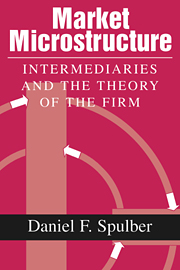Book contents
- Frontmatter
- Contents
- Preface and acknowledgments
- Introduction
- Part I Market microstructure and the intermediation theory of the firm
- Part II Competition and market equilibrium
- 3 Competition between intermediaries
- 4 Intermediation and general equilibrium
- Part III Intermediation versus decentralized trade
- Part IV Intermediation under asymmetric information
- Part V Intermediation and transaction-cost theory
- Part VI Intermediation and agency theory
- Conclusion
- References
- Index
4 - Intermediation and general equilibrium
Published online by Cambridge University Press: 18 December 2009
- Frontmatter
- Contents
- Preface and acknowledgments
- Introduction
- Part I Market microstructure and the intermediation theory of the firm
- Part II Competition and market equilibrium
- 3 Competition between intermediaries
- 4 Intermediation and general equilibrium
- Part III Intermediation versus decentralized trade
- Part IV Intermediation under asymmetric information
- Part V Intermediation and transaction-cost theory
- Part VI Intermediation and agency theory
- Conclusion
- References
- Index
Summary
The neoclassical theory of the firm, by its emphasis on the production-possibilities set, suggests a number of related explanations for the existence of firms. Firms are mechanisms for the application of productive technology. Their task is to select feasible input–output plans. The firm's input–output plans, including capital, labor, resources, and commodities, are a manifestation of its underlying technology. The production-possibilities set is something like a vast cookbook; the firm is charged with reading the recipes and combining input and output choices in the right proportions. Choosing these proportions involves selecting production plans that are not only feasible, but also technologically efficient, that is, plans that are on the upper boundary of the production-possibilities set. These choices are represented by the production function, which subsumes the firm's operational decisions that make the highest feasible output from any given inputs.
The firm manages the technology efficiently by choosing the profit-maximizing production plan, given market prices. This requires the firm to understand the productive trade-offs represented by the technology, marginal products of inputs, marginal rates of technical substitution across inputs, and marginal rates of transformation across outputs. As part of the choice of production plans, the neoclassical firm decides whether or not to enter output markets. The entry decision determines the number of firms in the long-run competitive equilibrium and thus establishes long-run aggregate supply.
The neoclassical theory firm makes clear that the firm combines inputs to produce outputs, purchasing inputs in factor markets and selling outputs in product markets.
- Type
- Chapter
- Information
- Market MicrostructureIntermediaries and the Theory of the Firm, pp. 81 - 114Publisher: Cambridge University PressPrint publication year: 1999



